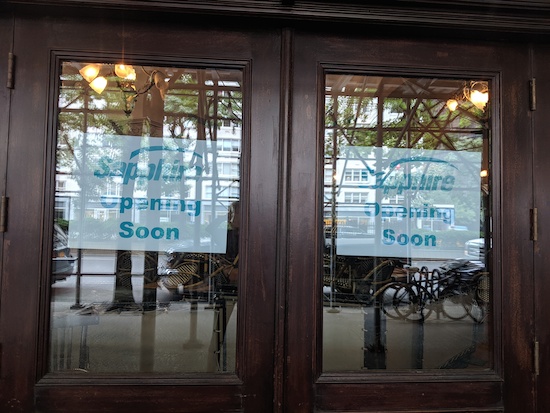Editor’s Note: Thomas Haines has published a memoir called “A Curious Life: From Rebel Orphan to Innovative Scientist” that includes this history.

The buildings Haines and his wife bought at 12 and 14 West 68th Street.
By Thomas Haines
As someone who started life in an orphanage, I never dreamed I’d one day become the landlord of two small apartment buildings on West 68th Street in New York City. Even then, I regarded landlords as enemies. I supported rent control and worked with Assemblymember Richard Gottfried advising tenants of their rights.
It happened because my artist first wife Adrienne Rappaport, who painted as Adrian Rappin, needed a studio with constant north light, yet close to the galleries on Madison Avenue. After we looked for a couple of years, a relative suggested we buy a building. Buy a building? We had no money; I had just become an assistant professor of chemistry at the City College of New York. But back then in the early 1960s the Upper West Side was a slum, and real estate was cheap.
 We found the perfect studio for Adrienne on the top floor of an old mansion, 14 West 68th Street. It was one of a pair of buildings, 12 and 14 West 68th, on a double lot behind the Christian Science Church on Central Park West. 14 West was originally the August Zinsser mansion, built in 1896. It had rough brownstone on the two lower floors, ornate brick terracotta on the three upper floors and a gabled slate roof. In 1916, it had been chopped up into twelve apartments and an Otis elevator was put in. The apartment that became Adrienne’s studio had a 22-foot ceiling with a north-sloping roof, into which we installed a skylight. The other building, 12 West 68th, was a small walkup “taxpayer” with 20 studio apartments, built in 1923 at the back of the garden.
We found the perfect studio for Adrienne on the top floor of an old mansion, 14 West 68th Street. It was one of a pair of buildings, 12 and 14 West 68th, on a double lot behind the Christian Science Church on Central Park West. 14 West was originally the August Zinsser mansion, built in 1896. It had rough brownstone on the two lower floors, ornate brick terracotta on the three upper floors and a gabled slate roof. In 1916, it had been chopped up into twelve apartments and an Otis elevator was put in. The apartment that became Adrienne’s studio had a 22-foot ceiling with a north-sloping roof, into which we installed a skylight. The other building, 12 West 68th, was a small walkup “taxpayer” with 20 studio apartments, built in 1923 at the back of the garden.
In February 1965, we paid $140,000, $10,000 down. A bargain! We had to borrow from friends to raise even that.
Meanwhile, we had a building to manage. Our first phone call came from an elderly tenant, Marjorie Devoe, who said, “My spark plug doesn’t work,” meaning she’d blown a fuse. She was virtually stuck on the top floor of 12 West because she couldn’t do stairs. Instead, she would use the elevator in 14 and cross a plank to the top floor of 12. We moved her down to a ground floor studio in 14. She had been a Ziegfield Follies dancer. She showed us her portfolio—gorgeous 8×10 glossy black and white photos of her posing with almost nothing on. There were two retired opera singers in 12, and a well-known jazz singer from Tennessee, Gail Wynters. All the tenants in 12 and most in 14 were rent-controlled, some paying as little as fifteen dollars month. Most had been there for decades and would leave only when they died.
A young actor applied for the job of super. Al Pacino was a student at the Actors Studio on West 44th Street, where Marlon Brando was one of his teachers. He moved into a tiny studio on the ground floor of 12 West; on his door he hung a big picture of his face, and underneath it said “SUPER.” Pacino rarely got home before three in the morning and would emerge bleary-eyed from his apartment at 7:00 a.m. to vacuum the halls. Our eighty-year-old managing agent would yell at him, “You’ll never amount to nothing if you don’t get up early and go to work!” Pacino had a heavy program acting and directing plays, leaving little time for his duties. After two years, and many warnings, I finally fired him. There were no hard feelings because his career was taking off.
We had light and space, but we also had a building with many problems. I discovered muscles I didn’t know I had when I worked in the basement on weekends to replace corroded galvanized pipes with brass. How lucky that I had been taught basic plumbing at the orphanage! We patched, painted, and planted flowers in the garden. The rents were so low that the buildings continually lost money, but as a result I paid no taxes on my salary. Adrienne worked at her easel in her top floor studio and we lived in a big one bedroom on the second floor. Our daughter Avril was born in 1969. Our careers were flourishing: Adrienne’s as an artist and mine as a chemistry professor.
Then, disaster. In 1978, Adrienne, a heavy smoker, was diagnosed with emphysema and given only months to live. We bought and moved into a nearby three-bedroom apartment to accommodate her aides, taking out a big mortgage on the buildings to pay for it. Adrienne actually lived until May 1985, with me and Avril constantly at her side. The cost of her round-the-clock care was staggering.
In 1986, I married Polly Cleveland, an economist who was then teaching accounting at Rutgers. When we moved back into 14 West, Polly discovered a horrifying situation: I was heavily in debt, even after selling the three-bedroom. The buildings were crumbling from years of neglect during Adrienne’s illness. The copper gutter on 14 had rotted through and a large Ailanthus tree was growing in it. When it rained, water sheeted down inside the walls all the way to the basement. The electrical system was ancient and dangerous. Tenants’ fuses kept blowing. The front garden was an overgrown mudslide. Polly made me face reality. Judging by the dumpsters and construction vans up and down West 68th Street, the neighborhood was turning around. Either we had to sell my beloved buildings, or borrow money to renovate. But if we borrowed, how could we raise rents enough to repay the money?
The banks wouldn’t touch us. We found a private lender, who advanced us money at 16%. Construction began with the roof and the only vacant apartment we had at the time, a big top floor two-bedroom. We expected it to rent for enough, over $2000, to qualify for “luxury decontrol.” That wouldn’t work for smaller apartments. We stumbled into a solution. I had brought in furniture from the three-bedroom, including furniture from Adrienne’s recently deceased mother. When Polly moved in, she brought all her furniture. Our apartment looked like a junk shop, with tables, chairs, dressers and bookcases heaped in corners. Why not get rid of the furniture by putting it in apartments when they came vacant, and renting furnished? Since rent control only applies to permanent residents, we could charge market rents.
That’s how we got into the furnished rental business. Bit by bit as the old tenants died or moved away, we gut renovated apartments and rented furnished. In our location not far from Broadway and Lincoln Center, we attracted actors and opera singers who came to New York for stays of a few months. Moreover, we welcomed pets—a blessing to many of our clients who brought their comfort animals. For example, Actress Kristin Davis of Sex in the City brought a large red setter. It chewed up a couch, which she paid for without complaint.
In the first years, we couldn’t raise rents fast enough to pay our lender; fortunately, he proved willing to renegotiate the loan. But as the neighborhood improved, our rental income rose until it more than covered costs—allowing us to support a drug policy reform organization operating from our living room. Come the aughts, however, Polly began to worry that this wasn’t just a boom, but an international bubble that would soon collapse, catastrophically. After all, she said, a huge real estate bubble in the Roaring Twenties preceded the crash of 1929. Time to sell, she said. Reluctantly, I agreed. I especially hated to give up the garden. In summer of 2008 we listed the property for an astounding $22 million. Nibbles came and went, but the market stalled, and then crashed in September 2008. We were very lucky to get about $10 million in early 2009. We ended up with some $3 million after paying off the mortgage and other expenses.
From $140,000 to $3 million in 44 years is about a 3% return, adjusted for inflation, but the buildings also gave us years of free rent and tax deductions on my salary. A windfall, merely from the lucky accident that my first wife needed a studio and that society would later make the property much more valuable. Polly and I spent half the money to buy ourselves a nice two-bedroom co-op on West 72nd Street, and put the other half into a small foundation to support research in science and economics.
New rent control laws just adopted in New York eliminate luxury decontrol and severely limit increases allowed for renovation. These laws would have prohibited us from renovating and renting furnished to get out from under rent control. I still support rent control. But I wonder if there aren’t better approaches—such as taxing the windfall gains of lucky landlords like me and using the money for more and better public housing.
Haines’ book with co-author Mindy Lewis is available here.








A great story. You should have been a professor of literature instead of chemistry.
That was a fascinating read and tells the story of the evolution of the neighborhood.
By Mr Haines’ own admission this building was literally rotting away when it was full of rent-controlled tenant.
He was only able to save the building when he was able to bring in some market rate tenants and apparently had the cash flow for proper maintenance and repairs.
Yet he still supports rent control.
It’s bewildering that he supports a flawed policy that by his own admission and experience has severely hurt NYC’s housing stock.
He says he had to take out another mortgage in order to buy a large apartment when his late wife was ill and that the cost of her seven years of care was “staggering.” He admits that during that time he neglected 12-14 so badly that he returned to a large tree growing out of a roof gutter. None of that was the fault of rent control, nor was the loss he had to take on the final sale price.
True.
Even if Mr. Haines had purchased the building either vacant or at lest free of RC tenants, the 1960’s through 1980’s were still the “big bad old days” of UWS. Thus it would be highly improbable they could get market rate rents anywhere near to service heavy debt.
Then and even today buying a brownstone/row house, mansion with existing tenants is not for faint of heart. You need rock solid fiscal plan on how the building is going to pay for itself, and or how *you* are going to pay for the building.
@ Chrigid
He stated that “our rental income rose until it more than covered costs”.
He is stating that as rent-controlled tenants died or moved out he had the cash flow to cover costs to properly maintain the building.
So yes, the building’s problems were largely the fault of rent control.
Sherm
Very enjoyable and well written. Good to see a humanistic owner.
Love this story!
Great story, would love more of these first person narratives. But it seems like he has a sort of Stockholm Syndrome relationship with rent control, which almost bankrupted him and destroyed two lovely buildings.
Haines writes: “From $140,000 to $3 million in 44 years is about a 3% return, adjusted for inflation, but the buildings also gave us years of free rent and tax deductions on my salary.” But he doesn’t give us all of the numbers, i.e., his estimates of the free rent, the inflation, and the tax deductions, so we can’t check his math ourselves. The 3% standing alone is meaningless. Perhaps it supports an unstated agenda.
You must have read a different article than I did. The one I read talked about buying two dumps and then being destabilized by a serious illness. That the buildings are lovely NOW is not an indictment of rent control .
A generation of creative people lived in rent stabilized apartments just like these on the UWS. Now you have people from the financial sector in market rate apartments. With them came the cold sterile UWS we have now.
We must have crossed paths along 68th Street as I was always peeking into the garden area of your building. We moved to the neighborhood in 1969 and our first polling place was a welfare hotel on 70th and Columbus.Back then 68th was a safer block than 69th, and we used to park our car in the lot located mod-block. We lived at 88 CPW for 25 years and watched the neighborhood go from rags to riches. Thanks for all the memories.
In general, is public housing nice?
As bad as the supertalls?
TY, Neal
Not sure rent control was the culprit of the buildings being rundown in the 60s and 70s. Sounds more like the result of the neighborhood being a self-described “slum” and rents too low to cover costs.
Rent control as it existed from WWII era was phased out/ended by the late 1960’s because in some ways it was harming landlords. Very little new rental housing was being developed, and what existed often was falling into rack and ruin.
By late 1960’s however landlord abuses began making news again so Albany came up with RS which went into effect in 1972.
RS essentially was RC *light* if you would and while it didn’t (IIRC) put all former RC apartments that came out into that system. Anything built prior to 1972 that was occupied became RS.
Today there is only a very small number of RC apartments, and those in them are seniors to elderly for most part.
Even with RS by the 1980’s there was again wide recognition rents weren’t allowing LL to service their buildings. Hence you got MCI increases added to RS laws. On another front during 1980’s and well into 1990’s some pretty steep annual increases were passed.
We’re talking numbers that would make people cringe today (between 6% to 9%)
https://tenant.net/Rent_Laws/RGBorders/apartment-html/rgb20.html
Or:
https://tenant.net/Rent_Laws/RGBorders/rgbtoc.html
Such an interesting story. Thank you for sharing!
What a great story. To all the chronic kvetchers on this site, perhaps you should think about this wonderful author the next time you reflexively cast blame on “evil and greedy landlords”
Nah. Cas by case basis; some landlords are nice, some are horrible. Too many horrible ones in this city…
True. A spotlight on one decent landlord doesn’t compare to the countless terrible landlords.
Wonerful article from some wonderful-sounding people. Thanks for this.
More article like this please! More first person narratives!
I just downloaded his book—what an amazing story. Praise to NYC schools and the orphanage that compensated for the parents who abandoned him!
Tom ,
What a wonderful and interesting article. I Am so glad Polly directed me to it . I will pass it along to many friends who I am sure will appreciate this NY story .
Warmest regards , Beth
What a nice story!! Enjoyed it very much. Thank you for sharing!
Loved this article and hearing about the life of 12/14….We were the first tenents in Al Pachino’s apartment after it was renovated. We told everyone that story. We painted a large floral mural on the back wall (behind Hotel Des Artists). Tom and Adrienne were great alndlords. We loved our space and the building and the neighborhood. We finally moved to Westchester but I came back years later and still live on the upper west side!
Posted a link to history of August Zinsser mansion, but guess it didn’t make the cut.
A simple Google search will bring it up and like many old mansions in city place has a rich history.
Happily UWS still has tons of brownstones, mansions, row and town houses from early 20th and even late 19th century like the August Zinsser mansion. A reflection of a time when UWS was either “the country” or later a bastion of proper middle class respectability.
Interestingly unlike the UES where Fifth going east towards Lexington remained mostly wealthy and or middle class; UWS from CPW going east didn’t enjoy that same prolonged heyday.
It was because of the downturn in UWS fortunes that Mr. Haines and others were able to nab those old UWS row houses/mansions for very little money. Those who bought back in the day and have managed to hold on are now being well rewarded.
A beautiful story, Tom!
Really enjoyed this story. I just walked passed those buildings last night and was admiring them. Didn’t hurt that Al Pacino, my favorite actor of all time, was a part of the story. WHOO aaaaahhhh. More stories like this one please!!
Al Pacino wasn’t the only actor/film star to live on that stretch of West 68th Street.
Mr. James Dean moved into top floor apartment of 19 West 68th in 1953. He was still living in the apartment (at least when in NYC) when he died in a car crash on September 30th, 1955. Though many years have passed now, fans still pay tribute to Mr. Dean by stopping by and perhaps leaving flowers at this former bachelor pad apartment building.
Leave us put things in perspective.
Just across street 15 West 68th sold on 2 February 2007 for a bit over $14 million. Having been converted from private home to apartments in 1941 it surely held RC and or RS tenants. Full conversion back to a private home wasn’t completed until 2017 according to DOB. So maybe new owners used that time to “move out” any remaining tenants.
What a wonderful story! Thanks for sharing. Beautifully told and provides a picture of the times!